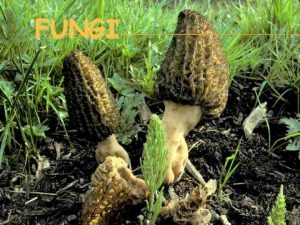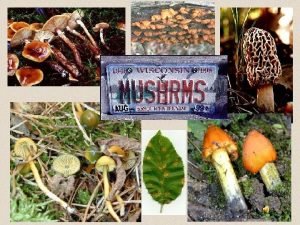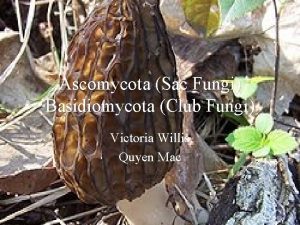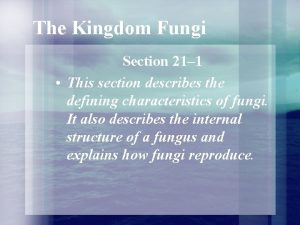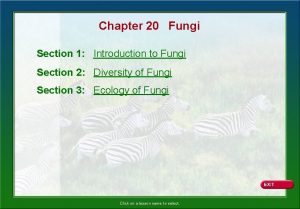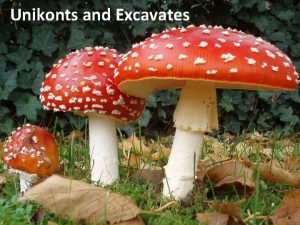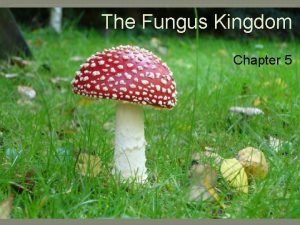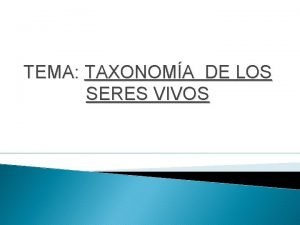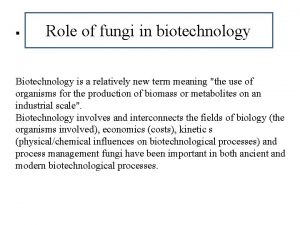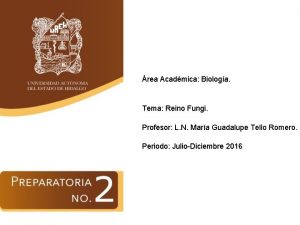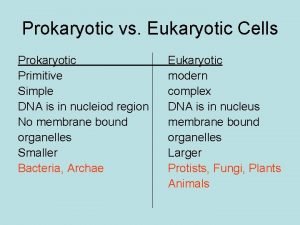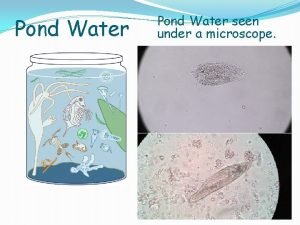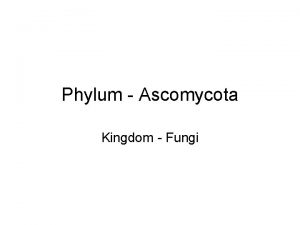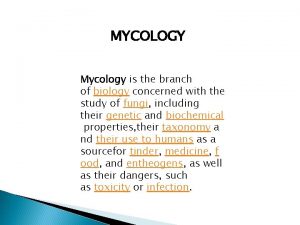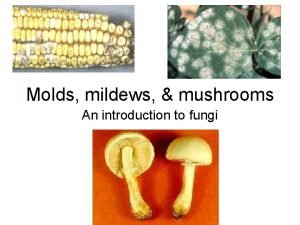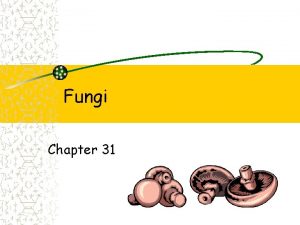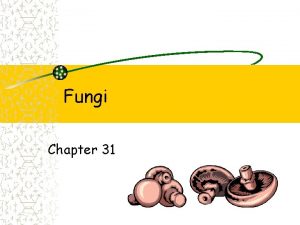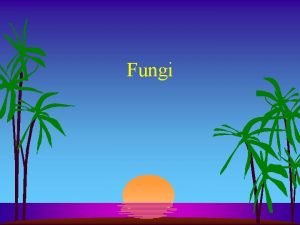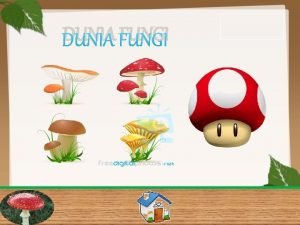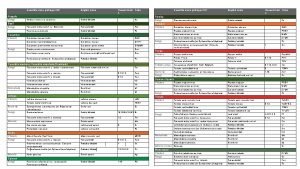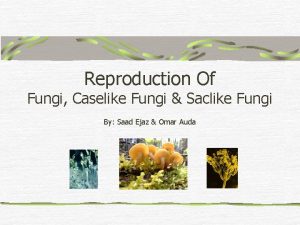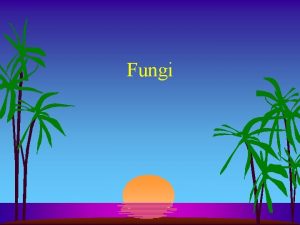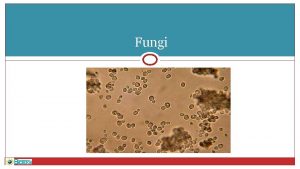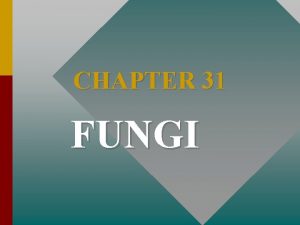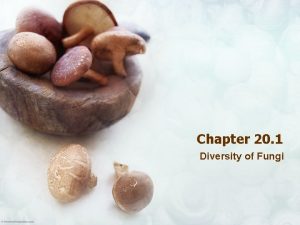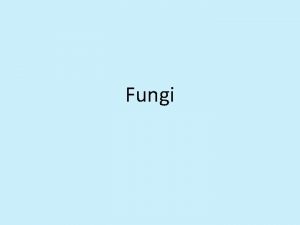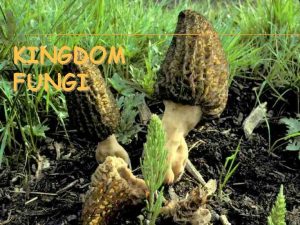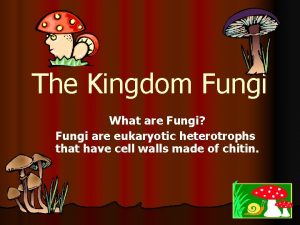Fungi Section 1 CH 22 Fungi Fungi Section


























- Slides: 26

Fungi Section 1 CH 22 Fungi

Fungi Section 1 What Are Fungi? • Fungi are a very diverse group of organisms, but all fungi share three characteristics: – Fungi have threadlike bodies – Fungal cell walls contain chitin – Fungi absorb nutrients from their environment

Fungi Section 1 What Are Fungi? • A fungus body is made of long, slender filaments. The filaments weave more tightly to form reproductive structures, like mushrooms and brackets. • Fungi have cell walls that contain chitin. Chitin is a tough carbohydrate that is also found in the hard outer covering of insects and other organisms. • Fungi obtain energy by breaking down organic and inorganic material in their environment and absorbing the nutrients.

Fungi Section 1 Structure and Function • Most of the body of a fungus is hidden in the ground or in the substance that the fungus feeds on. • The filaments allow the fungus to have a large surface area and to absorb nutrients efficiently.

Fungi Section 1 Visual Concept: Characteristics of Fungi

Fungi Section 1 Structure and Function, continued Body Structure • The threadlike strands of a fungus body are called hyphae (singular, hypha). • In some fungi, these cells do not have walls that separate the cells. Others fungi have partial cell walls, called septa. • Gaps in the septa allow cytoplasm, nutrients, and some organelles to flow through the hyphae.

Fungi Hyphae in Fungi Section 1

Fungi Section 1 Structure and Function, continued Body Structure • Hyphae form a tangled mass, often many meters long, called a mycelium. • In some fungi, hyphae also form rootlike structures, called rhizoids, that hold the fungus in place and absorb nutrients.

Fungi Section 1 Visual Concept: Body Structure of Fungi

Fungi Section 1 Structure and Function, continued Obtaining Nutrients • Fungi release enzymes that break down organic and inorganic matter into nutrients. • Fungi absorb the nutrients across their cell walls.

Fungi Section 1 Structure and Function, continued Obtaining Nutrients • Fungi that absorb nutrients from living hosts are called parasites. • In humans, fungal parasites sometimes cause diseases, such as athlete’s foot and ringworm.

Fungi Section 1 Reproduction Sexual Reproduction • Sexual reproduction occurs when hyphae from one fungus fuse with hyphae from a fungus of the opposite mating type. • The fused hyphae then form a reproductive structure, such as the mushroom. • Inside the structure, nuclei from the two mating types fuse. • These diploid nuclei undergo meiosis and produce haploid spores that are released.

Fungi Section 1 Reproduction, continued Asexual Reproduction • In fungi, asexual reproduction occurs when specialized hyphae produce haploid spores by mitosis. • The fungi that develop from these spores are genetically identical to the parent. • Fungi that do not have an observed sexual stage are grouped together and called imperfect fungi.

Fungi Section 1 Groups of Fungi • • Chytrid Fungi Zygote Fungi Club Fungi Sac Fungi

Fungi Section 1 Chytrid Fungi • The chytrids are a group of aquatic fungi that provide clues about the evolution of fungi. • Chytrids were once classified with protists because the two groups share two important characteristics. – Like protists, many chytrids are unicellular – Like protists, chytrids produce spores and gametes that have flagella.

Fungi Section 1 Chytrid Fungi, continued • Chytrids are now classified with fungi because chytrids have several important fungal characteristics. – Chytrids have chitin in their cell walls. – Chytrids digest food outside their bodies. – Most chytrids produce hyphae that form rhizoids. – The sexual reproductive structures of chytrids contain spores.

Fungi Section 1 Chytrid Fungi, continued • Most chytrids are aquatic, although some live in moist places on land. • They are mainly saprobes, which feed on dead algae or plants. • Some chytrids are parasites that feed on protists, plants, animals, or even other fungi.

Fungi Section 1 Zygote Fungi • Zygote fungi are named for sexual reproductive structures that produce zygotes inside a tough capsule. • Sexual reproduction in zygote fungi begins when hyphae from two mating types come together. • In fungi, different mating types are not referred to as male and female, because they are physically identical. Instead, they are called “+” and “-. ” • Asexual reproduction is more common than sexual reproduction in zygote fungi.

Fungi Section 1 Sac Fungi • Sac fungi are characterized by an ascus, a saclike sexual reproductive structure that produces spores. • The word ascus means “sac. ” • Sexual reproduction in sac fungi is similar to sexual reproduction in zygote fungi.

Fungi Section 1 Club Fungi • Club fungi are characterized by a basidium, a clublike sexual reproductive structure that produces spores. • Sexual reproduction of club fungi is very similar to that of sac fungi. • Hyphae from two mating types fuse and produce a dikaryotic reproductive structure called a basidiocarp. • A mushroom is one example of a basidiocarp.

Fungi Section 1 Club Fungi, continued • Basidiocarps often form at the outer edges of the large mycelial mats that club fungi produce. The mycelia grow out from a central starting point and form an expanding ring of hyphae. • When the fungus reproduces sexually, a ring of mushrooms appears. • The largest known organism on the planet is a club fungus in Oregon that is 3. 5 miles across.

Fungi Fungal Partnerships Section 1 • Fungi form mutualistic symbiotic associations to form lichens and mycorrhizae. • In a mutualistic relationship, both members benefit. • A lichen is an association between a fungus and a photosynthetic partner, such as a cyanobacterium, a green alga, or both. • The photosynthetic partner provides carbohydrates to the fungus. The fungus provides a protected environment, vitamins, and minerals. • Lichens can survive in extreme environments, such as on volcanic rock and arctic tundra. • Lichens can be damaged by chemicals in their environment and serve as indicators of air pollution.

Fungi Section 1 Fungal Partnerships, continued • A mycorrhiza is an association between fungi and the roots of nearly all plants. • The fungal hyphae grow inside or around the plant root and out into the soil. • The hyphae transfer phosphorus and other minerals from the soil to the roots of the plant. • The plant supplies carbohydrates to the fungus.

Fungi Section 1 Summary • Fungi have threadlike bodies, their cell walls are made of chitin, and they absorb nutrients from their environment. • A typical fungal body is made of filaments that allow the fungus to have a large surface area and to absorb nutrients efficiently. • In sexual reproduction in fungi, spores are produced by meiosis. In asexual reproduction in fungi, spores are produced by mitosis.

Fungi Section 1 Summary continued • The chytrids are a group of aquatic fungi that provide clues about the evolution of fungi. • Zygote fungi are named for sexual reproductive structures that produce zygotes inside a tough capsule. • Sac fungi are characterized by an ascus, a saclike sexual reproductive structure that produces spores.

Fungi Section 1 Summary, continued • Club fungi are characterized by a basidium, a clublike sexual reproductive structure that produces spores. • Fungi form mutualistic symbiotic associations to form lichens and mycorrhizae.
 Basidiomycota rusts and smuts
Basidiomycota rusts and smuts Deuteromycota
Deuteromycota Club fungi examples
Club fungi examples Section 21-1 the kingdom fungi
Section 21-1 the kingdom fungi Chapter 20 section 1 characteristics of fungi
Chapter 20 section 1 characteristics of fungi Section 21-2 classification of fungi
Section 21-2 classification of fungi Hidden lines are not generally omitted in a sectional view
Hidden lines are not generally omitted in a sectional view Broken section view
Broken section view What symbol is commonly used for half section view
What symbol is commonly used for half section view Section 2 describing energy (continued)
Section 2 describing energy (continued) Chapter 10 section 1 meiosis worksheet answer key
Chapter 10 section 1 meiosis worksheet answer key Eukaryotic supergroups
Eukaryotic supergroups Unicellular organims
Unicellular organims Define unicellular organisms
Define unicellular organisms Sac fungi
Sac fungi Nomenclatura binomial del ser humano
Nomenclatura binomial del ser humano Commensalism examples animals
Commensalism examples animals Role of fungi in biotechnology
Role of fungi in biotechnology O que estuda a micologia
O que estuda a micologia Características de los hongos
Características de los hongos Is an amoeba a prokaryote
Is an amoeba a prokaryote Unicellular fungi examples
Unicellular fungi examples Eubacteria protista
Eubacteria protista Phylum ascomycota
Phylum ascomycota Branch of biology concerned with the study of fungi
Branch of biology concerned with the study of fungi Monera protista fungi plantae animalia
Monera protista fungi plantae animalia Fungi
Fungi
